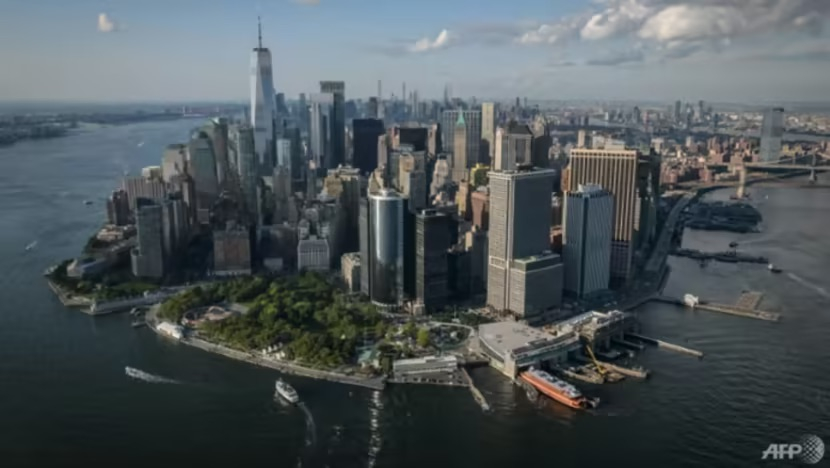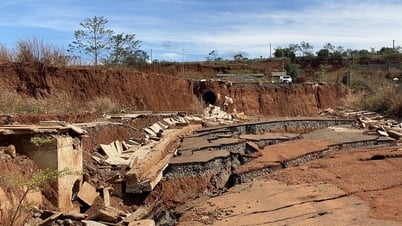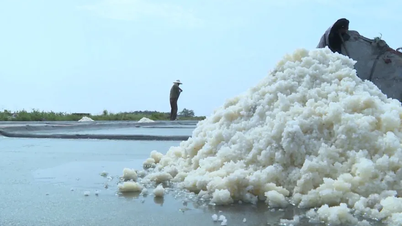New York is sinking
Planners failed to anticipate the risk of rising sea levels, which could spell trouble for the city's more than 8 million residents in the future, the study said.
A team at the University of Rhode Island has taken on the daunting task of estimating the total weight of the more than 1 million buildings that make up New York City.

New York is sinking under the weight of its skyscrapers. Photo: AFP
They found that nearly 1 trillion kilograms of concrete, steel and glass were pushing down on the ground, causing it to slowly sink below sea level.
At the same time, sea levels are rising due to global warming and climate change.
According to NASA, global average sea level has risen about 10 cm since 1992. It is predicted to continue rising between 20 cm and 75 cm over the next 25 years.
How fast is New York sinking?
According to research, sinking rates vary across the city depending on the area.
Wall Street, the famous eight-block stretch of New York's financial district, is only 1 to 2 meters above sea level.
Midtown Manhattan is built on rock, which has very little compaction, so its sinking rate is low. However, Brooklyn and Queens have looser soil, which causes it to sink more quickly.
Parts of Lower Manhattan have been artificially expanded by reclaiming land near the shore, leaving the ground more vulnerable to the gravitational pull of the buildings.
As a result, some areas of land there are sinking twice as fast, at rates of up to 4 mm per year.
Policy needs to change
The researchers said that while this is not an emergency, they wanted to provide scientific evidence to help with future planning.
In 2012, Hurricane Sandy tore through New York City, killing 44 people, destroying thousands of homes and infrastructure, and causing an estimated $19 billion in damage.
Every new high-rise could add to future flood risks, researchers warn, but construction shows no signs of stopping.
It is the waterfront areas that bore the brunt of the devastation from Hurricane Sandy and recent flash floods that have seen the highest rates of new housing development.
New York City - home to the highest housing prices in the US - will be hit hard as rising sea levels continue to erode its coastline, observers say.
“When we look across the United States, we can see talk of a significant amount of money being lost due to the impact of sea level rise,” said Peter Girard, vice president of communications for the research organization Climate Central.
The city ranks third in the world for property values affected by coastal flooding, after Guangzhou and Miami, which could mean huge losses for homeowners and investors if disaster strikes.
New York has led the way on other aspects of green infrastructure, such as regulating the carbon footprint of buildings. But it has no laws governing flood protection — a gap that experts say needs to be closed as soon as possible.
“It’s better to do it now than just put things off,” said Vrinda Mittal, a PhD student at Columbia Business School.
Industry observers say they expect tighter regulations to be imposed soon as New York seeks to protect its iconic skyline from rising sea levels.
Mai Anh (according to AFP, CNA)
Source


![[Photo] Buddha's Birthday 2025: Honoring the message of love, wisdom, and tolerance](https://vphoto.vietnam.vn/thumb/1200x675/vietnam/resource/IMAGE/2025/5/12/8cd2a70beb264374b41fc5d36add6c3d)
![[Photo] Prime Minister Pham Minh Chinh starts construction of vital highway through Thai Binh and Nam Dinh](https://vphoto.vietnam.vn/thumb/1200x675/vietnam/resource/IMAGE/2025/5/12/52d98584ccea4c8dbf7c7f7484433af5)




























![[Photo] General Secretary To Lam meets and expresses gratitude to Vietnam's Belarusian friends](https://vphoto.vietnam.vn/thumb/1200x675/vietnam/resource/IMAGE/2025/5/11/c515ee2054c54a87aa8a7cb520f2fa6e)


































































Comment (0)